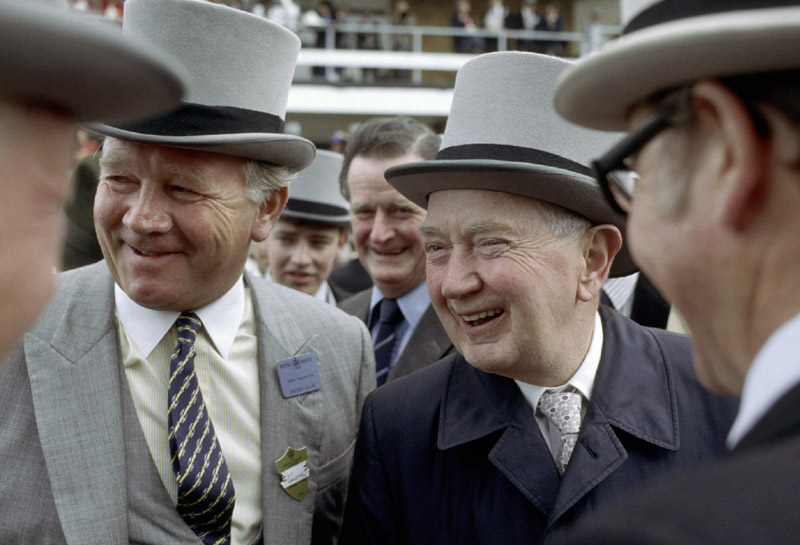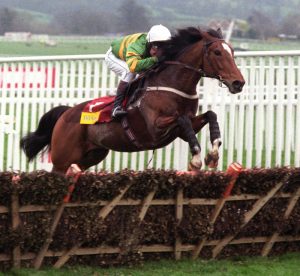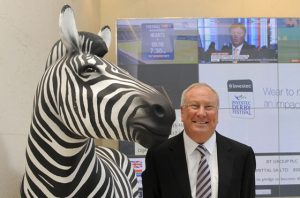Thirty years ago, if an owner or trainer wished to give himself the best chance of buying a yearling with genuine pretensions to winning the Derby, he was obliged to head to Kentucky for the Keeneland July Sale. While Britain was still home to a handful of established owner/breeders’ studs which collectively produced a few Classic prospects each year, the world’s best stallions were located in Kentucky, and the American yearling sales were thus the place where Europeans might find their Classic prospects.
Those days now seem a lifetime away. That is, of course, because they are a lifetime away: Sadler’s Wells’s lifetime. And it was largely the achievements of Sadler’s Wells during his glorious 30-year life which made the difference.
Sadler’s Wells, who died at his home at Coolmore Stud on April 26, almost single-handedly repaired the damage which had been done to Europe’s stallion ranks by the decades which had seen the pick of Europe’s Classic colts and stallions exported westwards. What the great Anglophile Paul Mellon had started when steering Mill Reef towards the British National Stud, Sadler’s Wells completed: the leading studs of Britain and Ireland are once more the home of the Classic racehorse.

Robert Sangster, left, and Vincent O’Brien
Bred by Robert Sangster in America, Sadler’s Wells was one of a batch of impeccably-bred colts to arrive at Ballydoyle in the autumn of 1982. A little dark bay colt very much in the mould of his father – with a sturdy body, strong legs and a bold but kind white face – Sadler’s Wells did not really stand out among Vincent O’Brien’s two-year-olds during the following year. Easily the star of the show appeared to be El Gran Senor, as his name implies. Sangster had come to share O’Brien’s reverence for Northern Dancer, the legendary Irish trainer having been introduced to the great stallion’s magic by the brilliant majesty of his second-crop son Nijinsky, whom he had trained to win the Triple Crown for Charles Engelhard in 1970. O’Brien and Sangster had vowed that, when they came upon Northern Dancer’s perfect son, they would name him ‘El Gran Senor’ in honour of the great horse’s trainer Horatio Luro – and El Gran Senor did indeed appear such a horse.
Having won the 1983 Dewhurst, El Gran Senor began the season under a weight of expectation, with Sadler’s Wells merely one member of a strong supporting cast. While lacking the obvious star quality of his paternal half-brother, however, Sadler’s Wells brought tremendous toughness and courage to the table, alongside his ever-more-apparent ability.
Having surprised his connections by winning the Irish 2,000 Guineas at 10-1 with veteran jockey George McGrath wearing Sangster’s second colours (Pat Eddery having preferred to ride Capture Him in the race), the little fighter went from strength to strength as the summer progressed. Come the autumn, he had trebled his tally of Group 1 victories, courtesy of hard-fought wins in the Eclipse Stakes (beating Time Charter) and the Phoenix Park Champion Stakes, and he had shown equal merit in defeat, splitting firstly Darshaan and Rainbow Quest in the Prix du Jockey-Club, and then Teenoso and Tolomeo in the King George VI and Queen Elizabeth Diamond Stakes.
“Sadler’s Wells was the most unbelievable stallion we could ever have wished for” – John Magnier
Despite the admirable racing record which Sadler’s Wells had compiled by the end of the year, El Gran Senor was still the one who radiated star quality, having recorded easy victories in the 2,000 Guineas and Irish Derby on either side of his famously agonising defeat at Epsom. He was duly sent back to the land of their birth to start a stud career which would be severely hampered by below-par fertility, while Sadler’s Wells took the short drive down the road to Coolmore Stud, where he would remain for the rest of his life. Thus began the most prolifically successful stud career which Europe has ever seen.
As a Group 1-winning son of Northern Dancer from a top-class half-sister to Nureyev, Sadler’s Wells was favoured with good mares right from the beginning, as his first-season stud fee of IR£125,000 implies. There is, however, the world of difference between being given opportunities and being able to capitalise on them – but as soon as Sadler’s Wells began to have runners during the summer of 1988, it was clear that he was more than worthy of so high a fee. By winning at Chantilly that June, In The Wings got the production-line rolling. By dead-heating in the Dewhurst, Scenic and Prince Of Dance then ensured that Sadler’s Wells ended the season already established as a sire of Classic prospects – and the rest is pretty much history.
Ultimately that first crop proved to contain six Group 1 winners, headed by the wide-margin Prix du Jockey-Club and Irish Derby winner In The Wings, while Sadler’s Wells’s second crop contained two more, including Salsabil. That wonderful filly, so much her father’s daughter, won four Group 1 races during her Classic campaign in 1990, including the 1,000 Guineas, Oaks and Irish Derby, thus doing much to help crown Sadler’s Wells as the champion sire of Britain and Ireland for the first time. This began an astonishing sequence: Sadler’s Wells was champion sire in 14 of the 15 years from 1990, the only exception coming in 1991 when Generous’s feats took fellow Coolmore resident Caerleon to the top of the table. To date, he has sired 73 Group 1 winners and, having been retired from active stud duties in 2008, his final crop of runners are three this year.
Tributes from breeding industry experts:
Kirsten Rausing: “Sadler’s Wells was more than a legend. He formed the basis of Coolmore’s enormous success but in so doing also formatted the European and, to an extent, worldwide development of the thoroughbred breed in the late 20th century. His influence in the thoroughbred industry will, of course, be everlasting, equalled so far only by St Simon in the 19th century and by his own sire Northern Dancer, contemporarily.
“All modern thoroughbred breeders will be grateful to have lived through the Sadler’s Wells era. All of us lucky enough to have seen and touched the great horse will forever remember him.”
Andrew Caulfield: “Superlatives are greatly overused in the world of sport, but no-one could begrudge their being used about Sadler’s Wells, with his phenomenal record of 14 sires’ championships in the space of 15 years. No stallion has come close to such dominance in Britain and Ireland – not even the legendary stallions which operated during the much less competitive eras of the 18th and 19th centuries.
“He was also dominant in that it was usually easy to spot one of his progeny. A dominant bay who sometimes passed on his prominent blaze and a sock or two, he also became synonymous with soundness and dependability.”
“The great horse may have died but his influence is far from gone from our lives.”
Alex Scrope: “Sadler’s Wells has the ability to become one of the rarest of influences in the thoroughbred breed. Already he has proved himself to be a sire capable of siring sires as good as himself and daughters who have repeatedly raised him to the top of the broodmare sire lists. There are those great stallions which produce horses as good as or better than themselves on the racecourse but whose influence at the highest level lasts only for their own lifetime. There are very few who pass on the ability not only to race to the highest level but also to produce both sons of equal stature as sires and superb broodmares, and to create a genuine dynasty.
“Phalaris was foaled in 1902 and by 2010, 34 of the 36 individual European three-year-old Group 1 winners during the season descended from him in tail male line. Thirty-one of the 34 descend from his grandson Nearco. Nearco was foaled in 1935 and died in 1957. Nearco has taken over as patriarch of the breed in Europe half a century after his own death and from this point in history it appears that Sadler’s Wells may prove to be the next of these illustrious rarities. Time will tell.
“The great horse may have died but his influence is far from gone from our lives.”
John Magnier: “Sadler’s Wells was the most unbelievable stallion we could ever have wished for. He brought Coolmore to a completely different level. We have a lot to be grateful to him for and are delighted to have four of his very best sons standing here.”
SIRE OF SIRES
Though initially there was a question mark over Sadler’s Wells’s claim as a sire of sires, the likes of Galileo and Montjeu in particular have long since erased any doubts. His sons can be found the world over but Coolmore arguably hold the crown jewels in the aforementioned duo and High Chaparral. It was fitting that in the week following his death, the two horses to set the racing world alight were his grandsons Frankel and So You Think, sons of his Derby-winning duo Galileo and High Chaparral.
The international influence of Sadler’s Wells:
SIRE (country where most successful)
GALILEO (IRE/AUS)
MONTJEU (IRE/NZ)
HIGH CHAPARRAL (IRE/NZ)
IN THE WINGS (IRE, deceased)
BARATHEA (IRE/AUS, deceased)
EL PRADO (USA, deceased)
SCENIC (AUS, deceased)
CARNEGIE (AUS/JPN, retired)
POLIGLOTE (FR/ARG)
ALNASR ALWASHEEK (IND)
FORT WOOD (SA)
OPERA HOUSE (JPN)
DUSHYANTOR (CHI)
STAGECRAFT (CHI)
SADDLERS’ HALL (GB, deceased)
SHOLOKHOV (GER)
And some grandsons to follow:
AUTHORIZED
HURRICANE RUN
KITTEN’S JOY
MEDAGLIA D’ORO
NEW APPROACH
TEOFILO
BROODMARE SIRE
Sadler’s Wells was champion broodmare sire in Britain and Ireland from 2005 to 2010 inclusive, and he looks sure to remain amongst the most successful in this sphere for at least another decade.
Dam (Group 1-winning progeny)
SOVIET MOON (Workforce)
PLUM FAIRY (Stand To Gain)
VISIONS OF CLARITY (Pathfork)
RING OF MUSIC (Campanologist)
CHIANG MAI (Chinese White)
WELL HEAD (Conduit)
QUEEN TITI (Beethoven)
NOTE MUSICALE (Musical Chimes, Music Note)
INTERIM (Midships)
LADY ELGAR (Grand Couturier)
SEQUOYAH (Henrythenavigator)
SADIMA (Youmzain, Creachadoir)
MARYINSKY (Peeping Fawn, Thewayyouare)
GOSSAMER (Ibn Khaldun)
CLEPSYDRA (Passage Of Time)
SKY SONG (Laverock)
ROSE OF TRALEE (Serenade Rose)
BADIUS (Bad Girl Runs)
FIRST ACT (Heavenly Romance)
CORALINE (Reefscape)
IMAGINE (Horatio Nelson)
MYTH TO REALITY (Divine Proportions, Whipper)
KIROV PREMIERE (Cesario)
LEGEND MAKER (Virginia Waters)
MEMORY (Verbena Rak)
WELLS FARGO (American Post)
THAWAKIB (Sakhee)
SADDLERS GAL (El Condor Pasa)
ARVOLA (Diktat)
DANCE OF LEAVES (Medaaly)
OH SO WELL (Dark Moondancer)
REEM ALBARAARI (Morshdi)
ITQAN (Hello)
SWELL TIME (Sumati)
MINUTE WALTZ (May Ball)
SIRE OF JUMP SIRES
In the modern era, one hurdler stands head and shoulders above all others: Istabraq. A Sadler’s Wells half-brother to the 1984 Derby winner Secreto, clearly he was intended for greatness on the level, but after a Flat career which garnered two wins and four seconds from 11 starts, Istabraq was switched to hurdling with devastating effect.
The Aidan O’Brien-trained gelding (he had been trained by John Gosden on the Flat) won the Royal & SunAlliance Novices’ Hurdle at Cheltenham before annexing three consecutive Champion Hurdles, being robbed of a chance to secure a record fourth win in the race in the year of the Festival’s abandonment during the foot and mouth crisis. He also won Ireland’s Champion Hurdle three times. In total, he was successful in 23 of his 29 races over hurdles and was runner-up on a further three occasions.
The name Sadler’s Wells has figured fairly prominently in the jump sires’ tables over the last decade – most recently with 2010 Welsh National winner Synchronised – and Montjeu sired two winners at this year’s Cheltenham Festival: Champion Hurdle winner Hurricane Fly and Noble Prince.
But the National Hunt stallion list is inundated with sons of Sadler’s Wells specifically advertised under the jumping banner, with King’s Theatre and Oscar having been his most successful flag-bearers in the 2010/11 season, the former being responsible for Riverside Theatre, Captain Chris, Menorah and Cue Card, and the latter for Big Zeb, Peddlers Cross, Oscar Whisky and Oscar Time.
Most successful stallion sons under National Hunt rules:
ACCORDION
DR MASSINI
KAYF TARA
KING’S THEATRE
OLD VIC
OSCAR
POLIGLOTE
SADDLERS’ HALL
And some to follow:
ASK
BLACK SAM BELLAMY
BRIAN BORU
DOYEN
MILAN
YEATS





